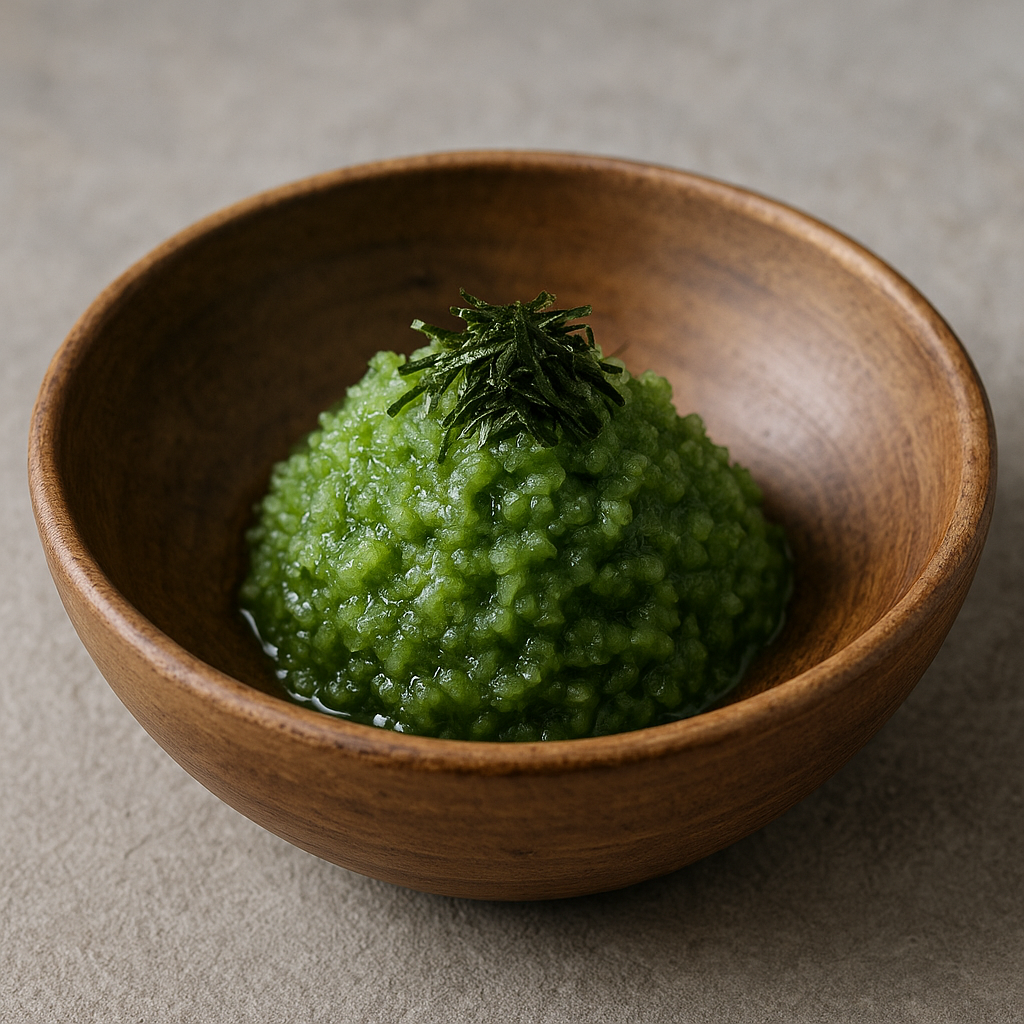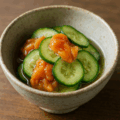みずたたき/みずとろろ(岩手)の特徴
山菜「みず」を刻んでたたき、味噌と香味野菜で“とろり”と仕上げます
みずたたきは、初夏に出回る山菜「みず(ウワバミソウ)」を細かく刻んでたたき、味噌と生姜・みょうが・青じそなどを合わせて粘りを引き出す郷土の一品です。みず特有のしゃっきり感と、たたいて生まれるとろみが調和し、冷やしても温かいご飯にもよく合います。
だしでのばせば「みずとろろ」に――食べ方いろいろ
味噌だれをだしで少しのばすと、さらりとした「みずとろろ」になります。ご飯にかけるほか、豆腐やそうめんに添えるなど、暑い季節の食欲を支える一品として親しまれています。
みずたたき/みずとろろ(岩手) レシピ
材料(5人分)
- みず(ウワバミソウ) … 400g(茎中心・葉も適量)
- 味噌 … 40〜60g
- だし(または水) … 30〜80ml(濃度調整)
- 酢 … 小さじ1(色止め・任意)
- 塩 … 小さじ1/2(下処理用)
- 白ごま/海苔など … 少々(仕上げ用)
作り方
- 下処理:みずは根元の汚れを落とし、硬い節や筋が気になる茎は薄皮をむく。3〜4cm長さに切り、塩をまぶして軽くもみ、流水でさっと洗って水気をよく切る。
- 刻む・たたく:みずを包丁で細かく刻み、まな板上でさらにたたいて粘りを出す(すり鉢に入れて半量ほど軽くするのも可)。
- 合わせる:味噌を少しずつ混ぜ込む。固い場合はだしでのばし、酢を少量加えて色と風味を整える。
- 味を調整:全体をよく混ぜ、塩味・濃度を好みに合わせて調整する。
- 仕上げ:器に盛り、白ごまや海苔を少量ふる。
- みずとろろにする場合:だしを多めに加えてさらりとした濃度にのばし、よく冷やして供する。
シェフのワンポイントアドバイス
- みずは刻んでから時間を置かずに調味すると、色と香りが冴えます。下処理の塩もみは軽めに。
- 味噌は少量ずつ加えて濃度を確認。だしで“とろりと落ちる”程度に整えると食べやすいです。
- 薄皮が硬い茎はピーラーで軽く引くと口当たりが良くなります。冷やすととろみが増してまとまりやすいです。
栄養価(1人分の目安)
- エネルギー … 40〜90 kcal
- たんぱく質 … 2〜4 g(味噌由来)
- 脂質 … 1〜3 g
- 炭水化物 … 6〜12 g
- 食物繊維・カリウム・ビタミンC … 山菜・香味野菜由来
歴史
初夏の山菜を“たたき”で味わう東北の知恵です
シャキッとした歯ざわりの「みず」を細かくたたき、味噌と香味でまとめる食べ方は、暑い時季に食欲を支える家庭の知恵として受け継がれてきました。
だし加減で広がる食べ方が地域に根づきました
濃いめに作ってご飯や焼きおにぎりにのせたり、だしでのばして「みずとろろ」として麺や豆腐に合わせたりと、家ごとの好みが今も生きています。
English Version
Features of Mizu-tataki / Mizu-tororo (Iwate)
Finely chopped wild green “mizu,” pounded and bound with miso for a silky finish
Mizu-tataki is a homestyle dish made by mincing and lightly pounding spring “mizu” (uwabamisō) to draw out a gentle viscosity, then blending in miso. The crisp bite unique to mizu meets a mellow, lightly viscous texture that pairs well with warm rice or chilled dishes.
Loosen with dashi for “mizu-tororo” — versatile ways to enjoy
Thinning the miso mixture with a little dashi turns it into “mizu-tororo,” a pourable topping. It’s tasty over rice, chilled tofu, or somen, supporting appetite in hot weather.
Mizu-tataki / Mizu-tororo – Recipe
Ingredients (Serves 5)
- Mizu (uwabamisō) … 400 g (mainly stems; a few leaves ok)
- Miso … 40–60 g
- Dashi (or water) … 30–80 ml (to adjust thickness)
- Vinegar … 1 tsp (optional, to help retain color)
- Salt … 1/2 tsp (for pre-salting)
- White sesame / nori … a little (for garnish)
Directions
- 1. Prep: Rinse mizu, trimming the base. Peel any tough outer skin from thicker stems. Cut into 3–4 cm lengths, sprinkle with the salt, massage lightly, rinse quickly, and drain very well.
- 2. Chop & pound: Mince the mizu finely with a knife, then chop-and-scrape to lightly “pound” on the board to draw out a slight viscosity (you can give half the batch a few turns in a mortar if preferred).
- 3. Mix: Work in the miso a little at a time. If too stiff, loosen gradually with dashi; add a splash of vinegar to brighten color and flavor.
- 4. Adjust: Stir until even; fine-tune saltiness and thickness to taste.
- 5. Finish: Plate and sprinkle a little white sesame or shredded nori.
- 6. For mizu-tororo: Add more dashi to a pourable consistency and chill well before serving.
Chef’s Tips
- Season soon after chopping so color and aroma stay lively; keep the pre-salting gentle.
- Add miso gradually, targeting a texture that “falls in a soft ribbon.” Adjust with dashi as needed.
- Peel tougher stems lightly with a peeler for a smoother mouthfeel. Chilling slightly increases the pleasant viscosity.
Nutrition (per serving, approx.)
- Energy … 40–90 kcal
- Protein … 2–4 g (mainly from miso)
- Fat … 1–3 g
- Carbohydrates … 6–12 g
- Dietary fiber, potassium, vitamin C … from wild greens and garnish
History
Tohoku wisdom: savoring early-summer mountain greens as a “tataki”
Finely chopping and lightly pounding mizu, then seasoning with miso, has been passed down as a refreshing home technique to keep appetites up in the heat.
Dashi adjustments shaped local styles
Some families make it thick to top rice or grilled onigiri, while others thin it with dashi as “mizu-tororo” for noodles or tofu—household preferences that continue today.



何でも質問してください!